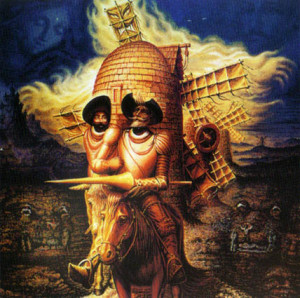A post covering 150p. seems daunting. It seems there’s a lot of ground to cover with this material. But at this point in the book, and the blog, the reason behind not posting every week is the book has started to lose momentum for me and the other readers. Many times over the past three weeks have I heard cries to quit the novel. To stop reading and admit defeat. We are now 800 pages in and the book ends p. 940. I am determined to finish it, however my determination to write and really look at this novel, to find something new in it, is waning.
Let me start from the beginning.
604-650ish.
The most remarkable thing is the cave of Montesinos. Where as I had to have pointed out to me is really a dive into Don Quixote’s subconscious. It is the things that he wishes to happen, the things he is afraid of, and filled with his insecurities. This chapter was also very influential to Freud’s understanding and research into the subconscious.
One thing about this chapter is that Don Quixote is insecure about his sex. I’ll be delicate and swift here since this is a public forum.
Essentially, in order to release Dorotea from the bondage of enchantment, she asks Don Quixote in the cave for six escudos. However he only has four to give. The Yale professors thinks this is a sign of Don Quixote’s insecurities around sex. I would also like to point out in regards to this that knight’s were not as celibate as I thought. Blaze pointed out to me that knights fooled around with all sorts of women on the road, but never thought about doing anything with their beloved ladies. Even if their ladies married someone else. The knight essentially used the lady, objectified them, took possession of them in their spirit to be invisible on the field. Does this sound true? I’m not so sure that sits right with me, although it is an interesting thought.
Basically, the cave of Montesinos, often said to be the most important chapter in the whole book, is simply one of Quixote’s dreams that he projects onto his present. It’s less than ten pages long.
There was also a very funny episode where Don Quixote crushed a puppet master and fortune telling monkey.
The fortune teller monkey is a monkey the puppet master has trained to jump up on his shoulder and act like he is whispering. Later on, we learn that the puppet master would go to a nearby village and learn everything that had recently happened there and go to the village and act as if they knew the past. The monkey would reveal things that already happened. Hence the puppet master’s trick. Also the puppet master is a man in disguise. He is the prisoner that Don Quixote freed from the galley’s. Apparently, he is the biggest trickster of them all.
During his play of a famous battle, Don Quixote gets up and crushes the puppets thinking the action was real and that he could have been of help. That gave us all a great laugh.
The next thing that happens to great knight and squire is they find a duke and duchess with wealth enough. And the one thing that makes this couple different from anyone else is that they are two people who have read and loved the Quixote adventure of book one that we’ve discussed has been written and published and read by many of the characters.
These two are thrilled to have the famous knight and squire stay with them in their castle. They treat them like royalty, however with an edge of humor. These two do no hesitate to make fun of Don Quixote and Sancho in the least. They are careful to how far they go as to not disturb the delicate delusion of Sancho who is constantly on the fringes of believing and not believing. The duke and duchess play continuous tricks on Don Quixote and Sancho. The duchess makes Sancho believe that Dorotea was indeed enchanted, and that it wasn’t he would fooled Don Quixote. They make Sancho give himself 3,300 lashes to release Dorotea from her enchantment. They make Don Quixote and Sancho sit on a wooden horse blind folded and light fireworks under them to send them flying through the air. All in the name of righting wrongs from some make believe Duennas.
Most importantly they give Sancho a governorship. And finally our two characters depart away from each other. And therefore Sancho takes most of the spotlight. His narrative is far more important and interesting. To say the least it most entertaining. Compared to the boring Don Quixote narrative where he gets attacked by a bunch of cats, and is in bed for some days, visited by various women.
Sancho on the other hand governs very well and in an odd style. He has interesting and unique ways of sifting out the wrong doers to find nuggets of justice. The only problem is that the duke has set him up with disloyal workers/assistants. One monitors what he eats and finds that this doctor/monitor won’t let him eat anything. Sancho starves throughout his rule as governor, which we readers know he does not like in the least.
Among the most interesting things said, Sancho has his moments. They are wonders that make me go huh. He is thinking in greater style or major human themes. These of course never last and are like shooting stars and if this book had more direction, it would have carried these sayings through. However that is not the case.
And lastly, there are more deliberate layers added to the whose writing this book question, which I have already gone over in detail in previous posts.
Not sure what else we’ll find in these next hundred or so pages, but I have a feeling it ends in a very anti-climatic style. Either way, I’m looking forward to moving on.

